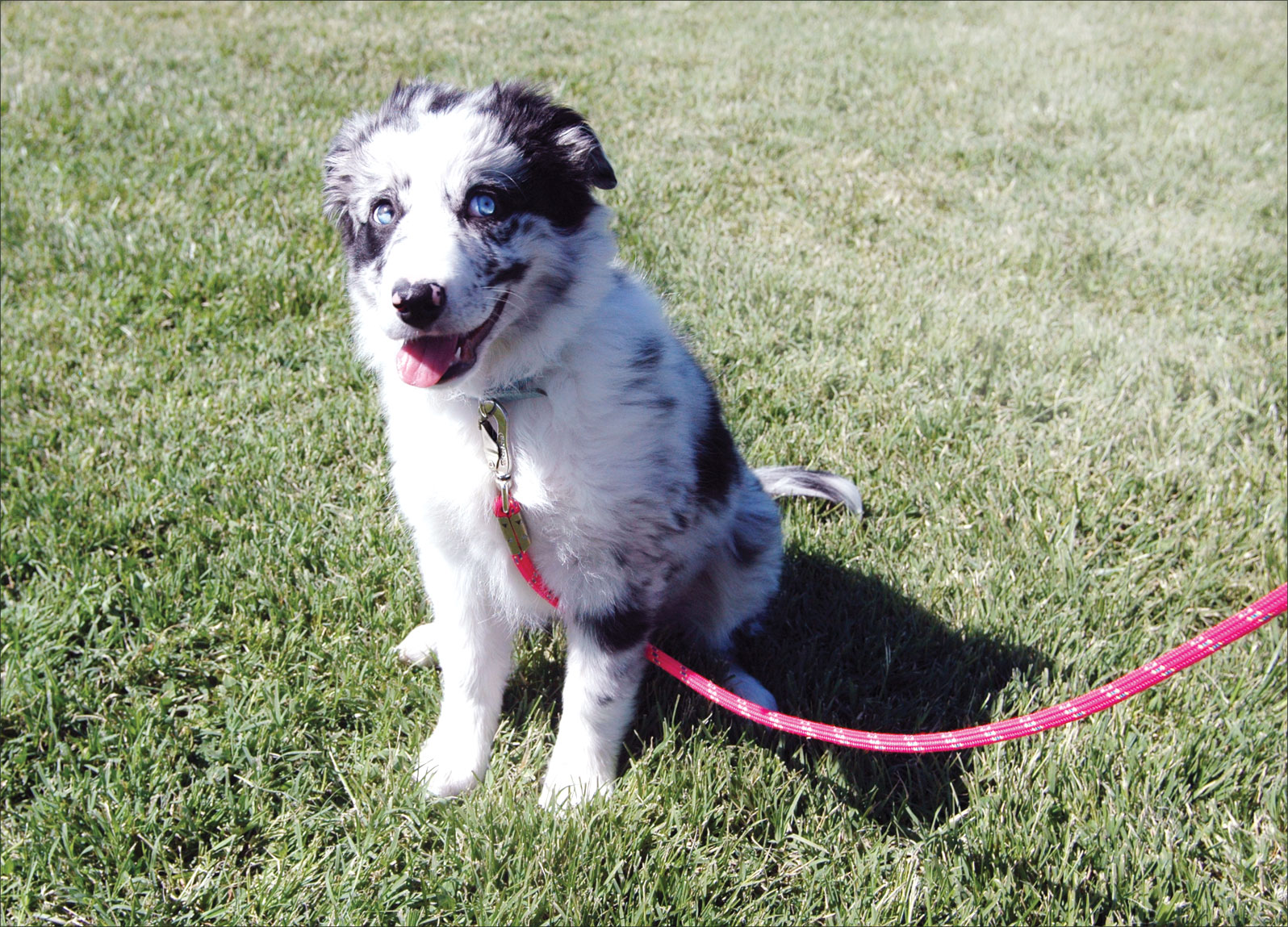[Updated January 28, 2019]
We’ve all seen dogs who exude impulse control – the ones who are calm in the face of excitement, and patient when it comes to getting what they want. Of course, we’ve all seen those dogs who are lacking impulse control, too – dogs who can’t seem to handle excitement and become overexcited, pushy, or reactive. Sometimes that lack of impulse control results in problem behaviors such as chasing cars, barking for balls, and jumping to say hi. Can dogs who are lacking impulse control learn this important life skill? Absolutely!

I recently had the pleasure of watching an Aussie-mix pup learn about impulse control from another pup. The 14-week-old Aussie started out pouncing and biting a little too hard for his Spaniel-mix playmate. The Spaniel started calmly stopping the play each time the Aussie went over the top, and inviting play when the Aussie calmed down. With each repeated stop and start, the Aussie began to pay attention to his body, his enthusiasm, and his teeth! He began approaching more slowly, pouncing more softly, and keeping his mouth open rather than clamping down. This lovely young Aussie learned about impulse control through a totally fun play session. (And the Spaniel obviously enjoyed the interaction, too!)
These pups clearly demonstrated that the key to learning impulse control is through experiences and actions . . . and the consequences those actions bring. They also showed that impulse control can be learned quickly when the consequences involve fun.
All types of consequences (both positive experiences, such as invitations to play, and negative experiences, such as the play ending) influence the development of impulse control. Fortunately, most dogs can learn this important skill from us as well as through their interactions with other dogs. A very effective way to help your dog learn impulse control is through a variety of enjoyable games and interactions.
Relaxing Is Rewarding
Many dogs who have trouble with impulse control really don’t understand that being calm is an option. For these puppies and dogs, learning that they can settle and that calm behavior is rewarding is the first step. Here are two activities you can incorporate into your daily life to help your dog learn that a calm, relaxed state is always a good option.
First, simply catch your dog in the act of being relaxed, for example, when she has settled on her bed or is sunning on the patio. When you see your dog settled, approach calmly with quiet praise or a gentle touch, and then drop a treat right near her paws or nose.
The first few times you do this, your dog may get up and follow you around to see if more treats might be forthcoming. If she does, simply go back to what you were doing without giving her more attention. After a few repetitions, your dog will learn to settle right back in after being rewarded.
A second activity is to reward your dog for relaxing at your feet. Start with your dog on a short leash so he can’t wander off or engage in another activity. Go to a nice quiet place. Stand or sit and wait for your dog to lie down. Please don’t cue your dog or otherwise encourage him to lie down. You may have to wait a long time – longer than you’d like to! – but just keep waiting. (This game is also a good way for people to practice impulse control; it really is best to wait for the dog to offer the behavior!)
When your dog offers the down, calmly say, “Good dog” and drop a treat between his front legs. You can offer additional treats to help your dog stay relaxed and settled.
Tips: Don’t use a clicker or other reward marker for this exercise, as this may encourage excitement instead of calm. If your dog is staring at you, do not treat. Wait until he is no longer thinking about the food before you drop another treat at his feet.
Waiting Is Worth It
Sit and wait is one of the most common impulse-control exercises because it works! Impulse control is in action as the dog learns to hold the sit or stay seated while you move away. Impulse control can be reinforced by generously rewarding when your dog stays sitting, even in the face of increasing distractions.
To make sit and wait fun, try adding “sit for everything” into your daily life. More specifically, ask your dog to sit before he gets anything he finds fun and valuable: Sit before walks. Sit to start tug, fetch, and chase games. Sit for treats and dinner. Sit before snapping off the leash for a romp in the woods. Whatever your dog gets excited about, have him sit and wait before doing it. Your dog will soon associate sitting and being patient with the opportunity to have fun and engage in enjoyable activities.
Tips: At first, simply request a brief sit from your dog before releasing him for fun or food. What if your dog doesn’t sit when you ask? Put more distance between your dog and the source of the excitement and try again. Gradually work closer to the excitement and extend the time your dog sits. Be sure to reward your dog when he starts to anticipate the sit and offers it without your asking. This is impulse control at work!
Get High and Settle
An important skill for impulse control is the ability to settle in the face of excitement. My favorite game for helping dogs learn to quickly calm down when they are super “high” is a tug/down/tug game. To play this game, your dog will need to understand a “Drop it” cue, a “Down” cue, and a release such as “Okay” or “Free.”
When you first play this game, do so at an intensity level that is low enough to keep your dog calm. Initiate a game of tug with whatever cue you use, such as “Tug!” or “Get it!” After just a few seconds, use your cue for asking your dog to drop the toy. When he drops it, immediately say “Okay” or use your release cue, and then start the game again. Repeat this first step a couple of times until your dog gets the idea that dropping the toy is what keeps the game going.
Next, begin the game of tug, ask for him to “Drop it,” and then cue your dog to “Down.” As soon as your dog hits the ground, give your release cue and start the tug game again with “Tug” or “Get it!” After a few repetitions of this, ask your dog to drop the toy and then wait for your dog to offer a down. Your dog may experiment or try something else – keep waiting. When your dog finally tries the down, immediately release him and initiate another great game of tug!
When your dog quickly offers the down, you can start to extend the time he stays down before you release him. At first you might just wait two or three seconds, but gradually wait to release him until he shows some sign of calming. For example, I look for my dog’s excitement to drop a notch as evidenced by a change in her breathing or eyes softening, and then I resume the tug game.
Over time, you can increase the intensity of the game so that your dog learns to listen, play, stop, and settle even in the face of increasing excitement.
Tips: If your dog gets overexcited in this game, play a very calm version of it with just a moment or two of tug. If your dog does not like to tug, try another similar “get excited and settle” game such as running around together with a stop and settle. Or, play with a flirt pole (a toy on the end of a rope, which is fastened to a pole) to get your dog running, and then incorporate the stop and settle.
Leave It Alone
Leave it (sometimes called “Off”) is a very powerful impulse-control exercise. It involves having the dog turn away from something that he is interested in and make eye contact with you instead. My favorite way to jump-start this behavior is through a “Doggy Zen” exercise. (Doggy Zen: In order to have the treat, you must leave the treat.)
Have a handful of super-exciting treats and one rather boring treat available. Put the boring treat in one hand and the good treats in a pouch or container behind your back. Present the boring treat to your dog in a closed fist (so she can smell it, but can’t get to it). Allow your dog lick and sniff your hand, and try to get to the treat.
The moment your dog backs away from your treat/hand a tiny bit, mark the moment with the “click!” of a clicker or with a verbal marker such as the word “Yes!” and give your dog one of the super-good treats from your other hand. Be very patient; the first try or two can take several minutes before a dog gives up and backs away.
Once your dog understands the game and quickly backs away from the treat in your fist, change it up a little by switching which hand is holding the boring treat. Again, reward with the yummy treat from your other hand.
Once your dog easily backs away from a boring treat in either hand, pause a moment after your dog backs away from the treat (without immediately marking or rewarding the behavior). Watch your dog carefully; almost always, after a few moments of not getting the expected reward, dogs will look at your face for information, trying to figure out why they haven’t been rewarded yet. The moment he offers that eye contact, click (or “Yes!”) and reward him.
When your dog easily backs off a treat and subsequently makes eye contact with you each time, add a verbal cue such as “Leave it.” Present the treat first, and when your dog takes notice, say “Leave it,” and click/”Yes!” and reward when your dog makes eye contact.

Tips: Be patient when waiting for your dog to back off from your fist; let your dog figure out what finally earns him the reward. To take this game to the next level, you can advance from holding the treat in a closed fist to an open hand, to putting the treat on the floor, or using a toy instead of a treat. By gradually increasing the difficulty of the “Leave it” task and rewarding your dog generously, he will learn that leaving something alone is more exciting and interesting than going for it!
Tricks for Tosses
Most dogs love to chase, run, and play. As with the “sit for everything” exercise described earlier, you can ask your dog to do another behavior before you start any active play-and-chase games.
With this game, instead of having your dog sit and wait, ask your dog to do an activebehavior – something that makes your dog move – before you toss a toy or release him to run with his pals. Some behaviors to ask your dog for include hand-targeting, spins, leg weaves, fall in to heel or go behind to heel, or coming to you from a short distance. By asking your dog to do something active, he will learn to pay better attention to you when his arousal level is still high. This helps your dog learn to “listen” to you even when he wants to chase, run, or play – a real challenge for some dogs.
Tips: Make it easy for your dog at first and ask for a behavior he knows very well. Some dogs will love this game from the start and consider the tricks all part of the fun; others may become frustrated by having to do something to make the ball fly. To keep your dog’s spirits and interest in the game high, try asking for just one trick and reward with several tosses.
Be Rewarding!
Building impulse control can take time and energy, but it can also be a totally fun way to spend time with your dog. Rather than making it all about self-containment, make sure your dog understands that calm and focused behavior is the way to keep fun happening, and a great way to keep rewards of all types flowing.
Because impulse control is challenging for some dogs, it’s important to make sure all of your impulse-control games and activities are offset with plenty of activities where your dog can let loose and have some uninhibited fun. In fact, to keep a dog enthusiastic about offering impulse control, balance every minute or two of impulse-control activities with several more minutes of fun.
For example, if you are playing the tug/down/tug game, every minute or so, take a quick break and simply toss the toy and let your dog have it, run around, and be goofy. The formula I use with my dog is that for every minute of impulse-control games, I incorporate five minutes or more of active, expressive activity.
Building impulse control can take time. Some dogs pick up the skills quickly, but some need a little more assistance. Just as the Aussie and Spaniel pups showed, experimentation, consequences, and having fun are the keys to successful impulse-control training.
Author/trainer Mardi Richmond, MA, CPDT-KA, lives and works in Santa Cruz, California. She shares her home with a wonderful partner and a joyful Cattle Dog-mix. Mardi is the owner of Good Dog Santa Cruz, where through classes and private training she helps dogs learn impulse control and other things.






Great article with easily understood, practical exercises for building your dog’s impulse control. Helpful to both trainers and owners/their dogs. This trainer’s emphasis on doing the impulse control exercises and then having the dog freely play is a good insight. Being given the time to freely play, the dog is less likely to get mentally tired and bored when doing the impulse control exercises. This builds success for the dog.
What if along with the impulse control also comes mouthing? (our dog it a 2 year old coonhound). The biting makes it really hard to sit and wait through that pain.